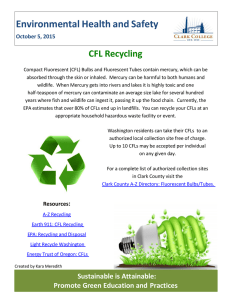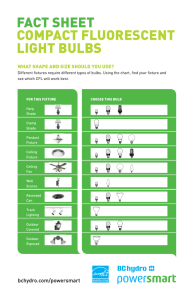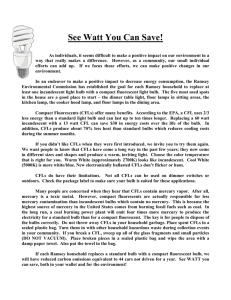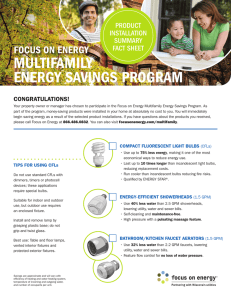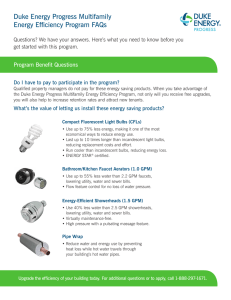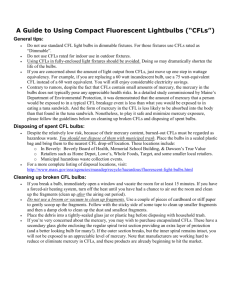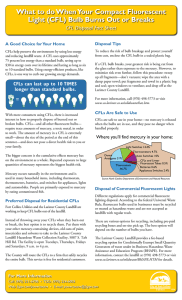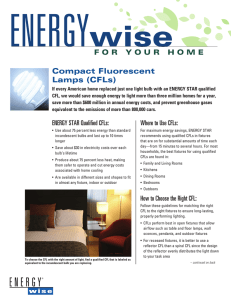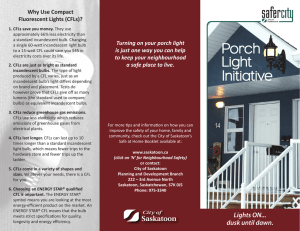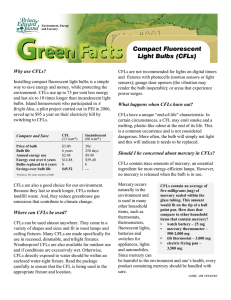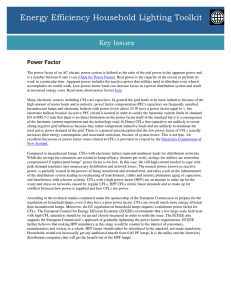Using CFL`s Light Output Equivalency
advertisement
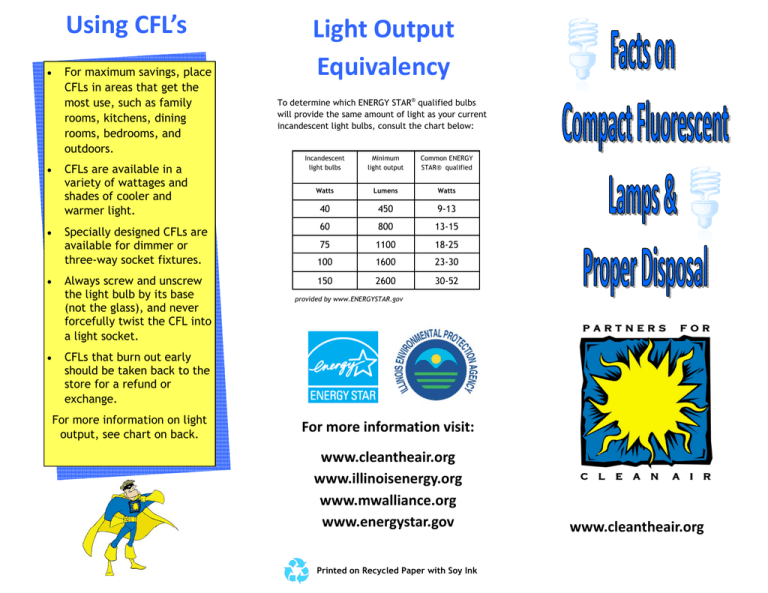
Using CFL’s • • • • • For maximum savings, place CFLs in areas that get the most use, such as family rooms, kitchens, dining rooms, bedrooms, and outdoors. CFLs are available in a variety of wattages and shades of cooler and warmer light. Specially designed CFLs are available for dimmer or three-way socket fixtures. Always screw and unscrew the light bulb by its base (not the glass), and never forcefully twist the CFL into a light socket. Light Output Equivalency To determine which ENERGY STAR® qualified bulbs will provide the same amount of light as your current incandescent light bulbs, consult the chart below: Incandescent light bulbs Minimum light output Common ENERGY STAR® qualified Watts Lumens Watts 40 450 9-13 60 800 13-15 75 1100 18-25 100 1600 23-30 150 2600 30-52 provided by www.ENERGYSTAR.gov CFLs that burn out early should be taken back to the store for a refund or exchange. For more information on light output, see chart on back. For more information visit: www.cleantheair.org www.illinoisenergy.org www.mwalliance.org www.energystar.gov Printed on Recycled Paper with Soy Ink www.cleantheair.org What are CFLs? Benefits Disposal Centers • Compact fluorescent lamps, or CFLs, are small fluorescent bulbs that use 75% less energy than traditional incandescent bulbs and last up to ten times longer. • CFLs come in a variety of shades and produce light typical of incandescent bulbs to fit almost any fixture indoor or outdoor. • • • • • One CFL bulb saves $30 in energy costs over its lifetime. • CFLs reduce emissions of greenhouse gases, mercury, carbon dioxide, and other pollutants. ® ENERGY STAR qualified bulbs are required to meet extensive safety and quality standards. CFLs are available at most stores for about $2. The energy used in the average home can be responsible for more than double the greenhouse gas emissions of the average car. When you use less energy at home, you reduce greenhouse gas emissions from power plants that cause global climate change. • CFLs contain a small amount of mercury, which poses no risk but should be disposed of at a special collection site. • CFLs produce about 75% less heat, so they are safer to operate and can cut energy costs associated with home cooling. If every home in Illinois replaced just one light bulb with an ENERGY STAR® qualified bulb, we would prevent greenhouse gases equivalent to removing 74,000 vehicles from Illinois’ roads. Chicago: Household Chemicals & Computer Recycling Facility 1150 N. Branch on Goose Island Tuesday 7 a.m.–12 p.m. Thursday 2–7 p.m. 1st Saturday of the month 8 a.m.–3 p.m. Lake County: Solid Waste Agency of Lake County (SWALCO) www.co.lake.il.us/swalco/events/hcw.asp Naperville: Fire Station #4 1971 Brookdale Rd. Saturday & Sunday 9 a.m.–2p.m. www.naperville.il.us/hhw.aspx DesPlaines: Residents ONLY Public Works 1111 Joseph Schwab Road Monday–Friday 9 a.m.– 3 p.m. Limit 4 Bulb Stores IKEA: “Free Take Back” program Bolingbrook: 630-972-7900 Schaumburg: 847-969-9700 ComEd has partnered with ACE Hardware, just bring your used CFLs to any participating Ace Hardware store near you. Home Depot: Collected at any Chicago area Home Depot store. To find a store in your area visit: www.earth911.org. If no collection programs exist near you, save your CFL for a Household Hazardous Waste collection. For updated schedules visit: epa.state.il.us
